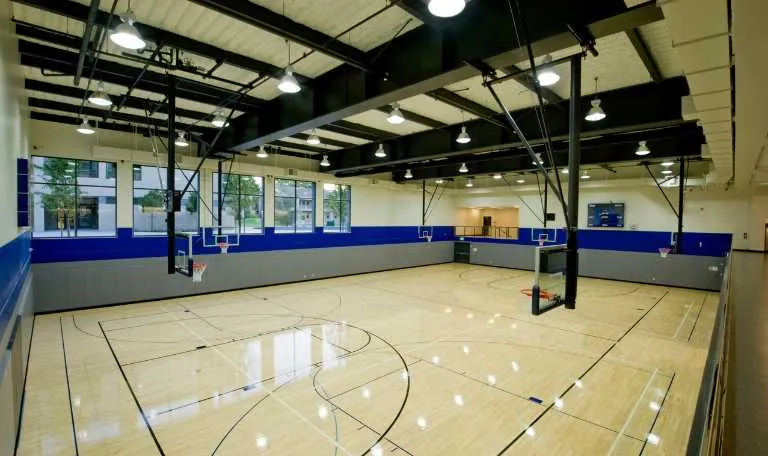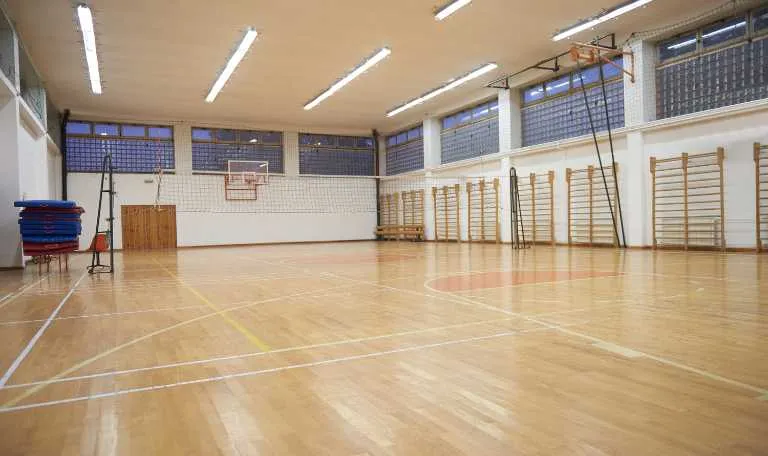Gym Light Fixtures Guide: Types, Cost & Funding

Proper lighting in gymnasiums, gyms, indoor sports arenas and courts is not merely a matter of convenience—it is essential for performance, safety, and the overall experience of athletes and spectators. With advancements in technology, LED lighting has emerged as the preferred choice over traditional lighting systems due to its efficiency, longevity, and superior light quality. This article explores various aspects of LED gym light fixtures for indoor sports courts, providing project owners with the knowledge to make informed decisions about lighting their sports facilities.
Get a customized cost estimate for your indoor sports lighting project by using our online cost calculator. Simply enter your project specifications, and receive a detailed quote in just two minutes!
Table of Contents
Benefits of LED Gym Light Fixtures
LEDs offer numerous advantages over traditional lighting solutions. They are highly energy-efficient, consuming significantly less power, which leads to substantial reductions in utility costs. The long lifespan of LEDs, which can reach up to 50,000 hours, greatly diminishes the frequency of replacements needed, reducing maintenance efforts and costs.
Additionally, LED lighting provides superior light quality with exceptional uniformity and the flexibility to control both the intensity and color temperature. Environmentally, LEDs are a more sustainable choice, reducing the carbon footprint and minimizing the waste and hazardous materials often associated with conventional bulbs.
Gym Light Fixtures: Cost of Installation
The cost of installing new LED lighting or retrofitting existing fixtures typically ranges between $19,000 and $252,000. This variation is influenced by factors such as the size of the facility, the type of LEDs selected, and the complexity of the installation.
Despite the substantial initial investment, the significant decrease in energy consumption and maintenance expenses associated with LED lighting can provide a compelling return on investment over time. Moreover, the duration of the installation project can vary, usually taking from a few weeks to several months, depending on the project’s scope and specifics.
Try our indoor sports lighting cost calculator to get a tailored cost estimate for your project.

Types of LED Lighting Fixtures Used in Gymnasiums
High Bay Gym Lighting Fixtures
High Bay LEDs are ideal for facilities with high ceilings, commonly found in indoor sports arenas and school gyms. These fixtures provide a broad and diffused light that covers large areas effectively, making them perfect for general illumination in gymnasiums.
- UFO High Bays: Named for their round, saucer-like shape, UFO high bays offer a compact, efficient lighting solution that distributes light evenly across a wide area.
- Linear High Bays: These are elongated fixtures that provide a broader distribution of light, ideal for covering larger or elongated areas with consistent illumination.
Mounting Options for High Bay Gym Light Fixtures
Typically, high bay lights in school gymnasiums and indoor sports facilities are either ceiling-mounted or suspended. Ceiling mounting is common in areas with fixed ceiling heights where broad, uniform light coverage is needed over large areas. Suspended high bays are used in arenas with high or variable ceiling heights to allow adjustments in the positioning and focus of the light, which can be crucial for adapting to different types of events and activities.
Technical Specifications
- Wattage: High bay LED lights are available in wattages ranging from 100 to 500 watts, yet they deliver illumination powerful enough to replace metal halide fixtures that consume 250 to over 1000 watts. This capability not only ensures substantial energy savings but also enhances efficiency, with many high bay LEDs achieving more than 130 lumens per watt (vs. 65 – 115 low for metal halides). This high efficiency translates into reduced operational costs and a lower environmental impact, making high bay LEDs a smart and sustainable lighting solution for large spaces.
- Lifetime: LED high bays boast impressive lifetimes ranging from 50,000 to 100,000 hours, drastically reducing maintenance compared to metal halide lamps which usually last about 15,000 to 20,000 hours.
- Color Temperature: Offering a range from cool to warm light (4000K to 6500K), they accommodate various lighting needs based on activity type or desired ambiance.
- Lumens: Output can vary broadly, often from 15,000 to 60,000 lumens, ensuring that every corner of the space is well-lit.
- Color Rendering Index (CRI): Typically above 70, which is sufficient for most sports and activities, but options with higher CRI are available for tasks requiring more accurate color differentiation.

LED Flood Lighting Fixtures for Gyms
Flood LED lights are typically utilized alongside high bay fixtures in sports arenas to provide focused, intense lighting on specific playing areas. This targeted illumination is essential for enhancing visibility during competitions and is especially beneficial for broadcasting purposes, where clarity and detail are crucial.
Mounting Options for LED Floor Light Fixtures
Flood lights in large sports arenas are generally mounted in elevated positions to maximize their effectiveness in focusing and directing light. They are most commonly found in the following setups:
- Pole Mounted: Flood lights are often mounted on tall poles or masts around the perimeter of the playing field or court. This placement allows them to cast a powerful, direct light from above the level of the audience, reducing shadows and glare that could affect players’ visibility and the viewing experience.
- Suspended: In indoor settings, flood lights can also be suspended from the ceiling or upper trusses. This setup is particularly useful for focusing light on specific areas of the arena, such as the playing surface, and is often used to enhance lighting for televised events where precise lighting control is necessary to meet broadcasting standards.
Technical Specifications
- Wattage: Flood LEDs generally range from 50 watts to over 1000 watts, catering to various intensity needs for both small and large areas. They can replace metal halide lamps ranging from 250 watts to 2000 watts, offering a more energy-efficient lighting solution.
- Lifetime: Flood LEDs boast an extended lifespan, typically 50,000 to 100,000 hours, significantly outlasting metal halide lamps which offer around 10,000 to 20,000 hours. This extended lifetime reduces maintenance and replacement costs.
- Color Temperature: Available from cool to warm white (3000K to 6500K), allowing customization based on the specific requirements of the sporting event or broadcast.
- Lumens: Flood LEDs can emit from 5,000 to over 100,000 lumens, providing the necessary brightness for detailed visibility in large spaces.
- Color Rendering Index (CRI): With a CRI usually over 70, and options available above 80, Flood LEDs ensure that colors are natural and vivid, which is particularly important for viewer experience during broadcasts.
- Lumens per Watt: Efficiency ranges significantly, often from 90 to 160 lumens per watt, making them a highly efficient choice for both environmental sustainability and operational cost.

Funding Options for Gymnasium Lighting Projects
Various funding sources are available for energy-efficient lighting projects, including grants, subsidies, and specific financing options aimed at educational and public sports facilities. These funding opportunities, combined with the potential for significant energy savings, make LED projects viable and attractive.
We have written extensively about grant and funding programs for sports lighting installations. Check out these articles:
Choosing the Right Lighting Partner
When selecting a lighting partner for your sports facility, consider the following crucial factors:
- Extensive Experience: Choose providers with a strong background in sports facility lighting.
- High-Quality Products: Ensure the provider offers high-quality lighting solutions.
- Project Management: Assess their capability to manage complex lighting projects efficiently.
- Customer Support: Evaluate the effectiveness of their customer service.
- Proven Track Record: Look for strong references or case studies demonstrating their reliability and performance on similar projects.
If you need help in finding a suitable lighting company for your project, try our sports lighting partner finder.
Conclusion
Upgrading to LED lighting in gymnasiums is a strategic decision that enhances the functionality and aesthetic of sports facilities while offering economic and environmental benefits. By choosing the right equipment and partners, project owners can ensure that their investment in gymnasium lighting meets current needs and future expectations, providing a well-lit, safe, and enjoyable sports environment.
Project owners in educational institutions, municipalities, and commercial sports facilities are encouraged to utilize this guide as a foundation for planning and executing their lighting upgrades, ensuring their sports facilities are illuminated effectively, efficiently, and economically.
Obtain a personalized cost estimate for your indoor sports lighting project quickly and easily. Use our online cost calculator, input your project specifications, and receive a comprehensive quote in just two minutes!
